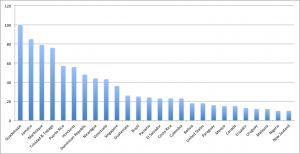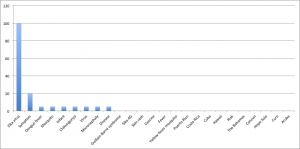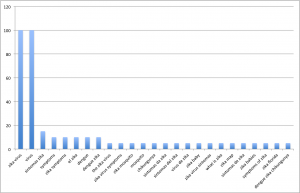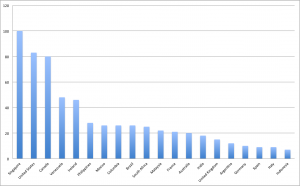
October 21, 2016, by Brigitte Nerlich
Searching for Zika: Where are the women?
Newsflash: Article based on more qualitative analysis now out!!
Media coverage of the Zika crisis in Brazil: The construction of a ‘war’ frame that masked social and gender inequalities (open access)
***
The Zika virus has attracted a lot of attention over the last year. For some people it’s a faraway threat, for some it’s a living reality. Many people want to know more about it and search for information. These searches leave traces and accumulate as trends in search behaviour. Out of curiosity I looked at some of these search traces and found some interesting differences between web searches and news searches, which I shall briefly explore.
In the following I’ll first say something about Zika, then about using Google Trends to look at information searches, then I’ll look at some search trends around ‘Zika’, and finally I’ll come to some tentative conclusions. This is of course a bit like sticking your finger in the wind and trying to guess the weather….I am basically just experimenting.
ZIKAV
Zika virus (ZIKAV) was first identified in rhesus monkeys in Uganda in 1947. It was detected again in 1948 in the mosquito Aedes africanus, which is the forest relative of Aedes aegypti. Aedes aegypti and Aedes albopictus can both spread the virus. These mosquitoes also spread dengue fever, yellow fever and chikungunya, which are endemic in countries such as Brazil. The mosquitoes that transmit the virus through their bites are female and thrive in urban surroundings in particular, especially in pools of stagnant water.
Scientists soon discovered that ZIKAV can also be transmitted sexually between men and women, through contaminated blood transfusions and through other routes, but most importantly, ZIKAV can be transmitted from mother to foetus. It also soon became clear that ZIKAV can lead to microcephaly in babies, as well as, for example, Guillain-Barré syndrome in adults.
The science writer Philip Ball has pointed out in a recent article on the explosive spread of ZIKAV that the “pandemic began in 2007, when several cases were reported in Gabon and in Micronesia—at first attributed to dengue fever, the symptoms of which are similar. In 2013 the virus had reached the islands of French Polynesia, where it is estimated to have affected about 11 per cent of the population. Then around 2013 it crossed the Pacific and entered Brazil, from where it has spread to Colombia, El Salvador, Suriname and Venezuela. There was no great international alarm, however, until the link with microcephaly started to look secure in late 2015.” The link is now firmly established.
In February 2016 the World Health Organization declared ZIKAV a public health emergency of international concern and Brazil declared war on ZIKAV. ZIKAV has now also spread to the United States, where Florida has become a hotspot and where Zika has become a hot political issue. Here is an interactive map, where you can follow the spread of the virus.
By September 2016 there was some talk of scientific successes in finding solutions and cures, but many still remain elusive. “A vaccine is now being tested in 160 people in Puerto Rico, and two drugs have emerged that may stop the virus from damaging the brain” (New Scientist, 3 September, 2016, p. 6).
Managing the pandemic is hampered by many scientific and political uncertainties, such as access to health care, health behaviour, poverty, gender issues and much much more. In this context it is not surprising that people, especially in countries where ZIKAV has spread or is threatening to spread, look for information on the internet. I should stress though that the following is only a snapshot in a fast-moving virus, web and news story.
Using Google Trends in social science research
Google Trends is a tool provided by Google for the visualisation of the popularity of search trends taken from a sample of all the searches performed by users of Google. I used Google Trends for this post and searches using other search engines were not included. Google, with a current share of 73.02 of the global online search market, holds the largest repository of online search trend data.
Using Google Trends data for social science comes with a list of caveats and limitations, too long to enumerate here. I just want to say a few things about the graphs that I’ll show below, for web search results and for news search results. I used ‘Zika’ as a key word and searched for the past year, between 15 October 2015 and 15 October 2015. The overall graphs showing what one might call the general trend-lines are based on indexed and normalised data and are generated through a rather complex process, but for users of Google Trends the trend graphs appear automatically.
The other graphs are based on CSV files that I downloaded to Excel. I then produced the graphs for the geographical spread, as well as for ‘related topics’ and ‘related queries’. ‘Related’ topics and queries means that users that searched for Zika also searched for other topics, or users that searched for Zika also used other search queries. I have focused on the most popular or top topics and queries (I did not explore rising ones). In both cases scoring is on a relative scale where a value of 100 is the most commonly searched topic/query, a value of 50 is a topic searched half as often, and a value of 0 is a topic/query searched for less than 1% as often as the most popular topic/query.
Web searches
Figure 1: Overall trend in web searches
This overall trend figure is easy to explain, as on 1 February 2016 the World Health Organisation declared “the cluster of microcephaly cases and other neurological disorders a health emergency” – a public health emergency of international concern. When issuing its statement, the WHO also said: “At present, the most important protective measures are the control of mosquito populations and the prevention of mosquito bites in at-risk individuals, especially pregnant women.”
As indicated in the introduction, ZIKAV spread widely amongst Latin American countries and beyond, and is still doing so.
Figure 2: Web searches by country; I cut off a long tale of countries were the number of searches was below 10.
In our project* we are particularly interested in Brazil (in fifteenth place in the web searches), which became a first real hotspot of ZIKAV and for international attention, especially in the context of the Olympic Games being held there in August 2016. Not surprisingly, people in regions into which Zika has been spreading more recently were also searching for information, especially, it seems, Guadeloupe, which is currently (September/October) experiencing a ZIKAV outbreak.
Figure 3: Web searches for related topics
The table above shows that people in our time-frame seem to have searched mostly for information about the virus, then symptoms and then related and endemic diseases in regions affected, namely dengue fever and chikungunya, as well as issues around ‘infants’ and ‘microcephaly’. They also searched for vaccines, risks and cures. This then is mainly a medical type of search activity.
Figure 4: Related queries in web searches
Here again we find that people looked for symptoms and other similar diseases, mostly it seems in Portuguese/Spanish (sintomas), as many of the countries affected, such as Brazil speak Portuguese or Spanish. People sometimes searched for three diseases together: dengue, zika and chikungunya, something that, again, situates these searches in Latin America rather than other countries.
News searches
We now turn to news searches and, as you’ll see the results are quite different to the web searches. Lets start with the overall trend figure.
 Figure 5: Overall trend of news searches
Figure 5: Overall trend of news searches
This graph has, again, a big spike in February 2016, but this is followed by an almost equal spike in August 2016 when Zika made the news during the Olympics in Rio de Janeiro and when ZIKAV crept gradually into the United States. Here the US congress blocked a Zika funding bill early in September but then passed legislation to deal with the Zika crisis by the end of September (second spike).
Figure 6: News searches by country
While web searches originated in countries mostly affected by Zika in Latin America, news searches came mainly from the US and Canada and, even more so, from Singapore where local Zika transmission was recently reported (October).
Figure 7: Related topics in news searches
In the context of news searches in United States (using Zika as a search term), it is perhaps not surprising that Google Trends found that people also searched for other topical issues and made topical queries. Related topics turned out to be Donald Trump and Hillary Clinton, two names that were and still are on everybody’s lips in the United States and beyond.
Figure 8: Related queries in news searches
In related queries we still find Spanish/Portuguese searches but much less than in the web sample. Overall though, in the news searches Zika is a political rather than scientific or medical issue, especially in the United States in general and in Florida in particular. Searches for symptoms of other diseases, such as dengue for example, have all but disappeared.
Searching for women
ZIKAV is a new and complex infectious disease, a pandemic and a public health crisis. It’s not just a virus that affects an individual but that affects the foetus. This has direct implications for women’s health and the managing of pregnancies.
As this brief analysis of search behaviour shows, ZIKAV plays out differently in different countries. While in Latin America the focus is on fighting the disease and dealing with its symptoms, in the United States the focus is on fighting between polarised political parties and their followers. The fight is about ‘planned parenthood’ and ‘contraception’, but none of these or similar words appear in ‘related topics’ or ‘related queries’, which is quite strange.
Gender also pervades dealing with ZIKAV in Latin America, “a region dominated by the conservative Catholic Church and riddled with poverty” and where “it should come as no surprise that birth control is neither universally accessible nor widely acceptable”. Again words like birth control don’t make an appearance in related searches.
The issue of ‘women‘ only made its appearance indirectly through politics in the news searches and searches for ‘infant’ or ‘microcephaly’ in the web searches. It did not show itself directly in any of the searches. It’s almost like the elephant in the room.
Data source: Google Trends (www.google.com/trends)
Image: By Daniel Sone (photographer) [Public domain], via Wikimedia Commons
*The project (dealing with Brazilian media coverage of Zika) is funded by the Governance and Public Policy Research Priority Area at the University of Nottingham.
No comments yet, fill out a comment to be the first








Leave a Reply